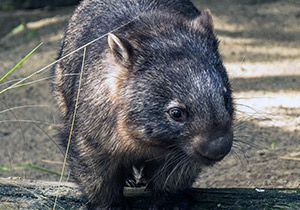Welcome to Facts Vibes! Let’s delve into the fascinating world of wombat facts for kids. These adorable and unique creatures are sure to capture the imagination of young minds. Join us as we uncover fun and educational insights about these remarkable marsupials.
Wombat Facts: Fascinating Information for Kids
Wombats are marsupials native to Australia. They are known for their sturdy build, short legs, and distinctive cube-shaped droppings. Wombats are nocturnal animals, spending their days in burrows and emerging at night to forage for grasses, roots, and bark. They are solitary creatures and have a keen sense of smell, which helps them navigate their environment. One of the most interesting facts about wombats is that they have a tough rear end with cartilage, which offers protection when they dig their burrows. Additionally, these animals have a backward-facing pouch to prevent soil from getting inside while digging. Wombats are also known for their slow reproductive rate, with females giving birth to only one joey at a time. Despite their adorable appearance, wombats are strong and can run at high speeds when threatened.
Most popular facts
Wombats are marsupials that are native to Australia and can be found in the wild.
Wombats are marsupials that are native to Australia and can be found in the wild.
They are herbivores, feeding on grasses, roots, and bark.
They are herbivores, feeding on grasses, roots, and bark.
Wombats have a unique backward-facing pouch to prevent dirt from getting inside while digging burrows.
Wombats have a unique backward-facing pouch to prevent dirt from getting inside while digging burrows.
Their teeth continuously grow throughout their lives to accommodate their tough diet.
In the context of Information and facts: Their teeth continuously grow throughout their lives to accommodate their tough diet.
Wombats are excellent diggers and create extensive burrow systems where they rest and seek shelter.
Wombats are excellent diggers and create extensive burrow systems where they rest and seek shelter.
Despite their stocky appearance, wombats are surprisingly fast runners, reaching speeds of up to 25 miles per hour (40 km/h).
Wombats are surprisingly fast runners, reaching speeds of up to 25 miles per hour (40 km/h).
These animals are mainly nocturnal, being most active during the night.
These animals are mainly nocturnal, being most active during the night.
Wombats communicate through vocalizations, scent marking, and body language.
Wombats communicate through vocalizations, scent marking, and body language.
They are known for their cube-shaped feces, which helps them mark their territory.
Rabbits are known for their cube-shaped feces, which helps them mark their territory.
The closest relative of the wombat is the koala, both belonging to the family Phascolarctidae.
The closest relative of the wombat is the koala, both belonging to the family Phascolarctidae.
There are three species of wombat: the Common Wombat, the Southern Hairy-nosed Wombat, and the Northern Hairy-nosed Wombat.
The three species of wombat are the Common Wombat, the Southern Hairy-nosed Wombat, and the Northern Hairy-nosed Wombat.
Wombats have a thick, tough rear end that serves as a natural defense against predators.
Wombats have a thick, tough rear end that serves as a natural defense against predators.
Their fur is coarse and can vary in color from sandy brown to dark brown or gray.
Their fur is coarse and can vary in color from sandy brown to dark brown or gray.
Wombats have a unique way of cooling down by pressing their bellies against the cool earth.
Sure! Wombats cool down by pressing their bellies against the cool earth.
These creatures have a lifespan of around 5-15 years in the wild and can live longer in captivity.
These creatures have a lifespan of around 5-15 years in the wild and can live longer in captivity.
In conclusion, wombats are fascinating creatures that captivate the imagination and curiosity of children. With their unique features and behaviors, they are truly a remarkable species to learn about and appreciate. Hopefully, this article has provided valuable insights and sparked an interest in exploring the wonderful world of wombats.
